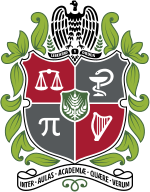This article needs additional citations for verification. (July 2018) |
Universidad Nacional de Colombia | |
 | |
| Motto | Inter-Aulas-Academiæ-Quære-Verum |
|---|---|
Motto in English | Search the truth in the rooms of the academy |
| Type | Public, National |
| Established | September 22, 1867 |
| Rector | Leopoldo Múnera Ruiz[1] |
Academic staff | 3,114 (2019)[2] |
Administrative staff | 2,932 (2019)[3] |
| Students | 53,304 (2019)[4] |
| Undergraduates | 44,621 |
| Postgraduates | 8,683 |
| 1,278[5] | |
| Location | , , 4°38′8″N 74°4′58″W / 4.63556°N 74.08278°W |
| Campus | Urban, 300 acres (1,214,056.9 m2) |
| Colours | Green and Red |
| Website | unal |
 | |
The National University of Colombia (Spanish: Universidad Nacional de Colombia) is a national public research university in Colombia, with general campuses in Bogotá, Medellín, Manizales and Palmira, and satellite campuses in Leticia, San Andrés, Arauca, Tumaco, and La Paz, Cesar. Established in 1867 by an act of the Congress of Colombia,[6] it is one of the largest universities in the country, with more than 53,000 students.[7] The university grants academic degrees and offers 450 academic programmes, including 95 undergraduate degrees, 83 academic specializations, 40 medical specialties, 167 master's degrees, and 65 doctorates. Approximately 44,000 students are enrolled for an undergraduate degree and 8,000 for a postgraduate degree.[8] It is also one of the few universities that employs postdoctorate fellows in the country.
The university is a member of the Association of Colombian Universities (ASCUN),[9] the Iberoamerican Association of Postgraduate Universities (AUIP),[10] and the Iberoamerican University Network Universia. Along with Antioquia and Valle universities, it is part of what is known as the Golden Triangle of higher education in Colombia,[11] being among the most selective and competitive universities in the country. The SCImago Institutions Rankings Iber by SCImago Research Group found that the National University of Colombia produced the largest number of scientific papers published in peer-refereed publications in the country, and was the 17th[12] (14th[13] in 2018) most prolific in Latin America. Furthermore, according to the Latin-American Web Ranking of Universities, the National University of Colombia ranks first place in internet presence in the country. It is also among the first universities in the region.[14] Among the universities of CIVETS countries, the National University occupied second place.[15] Globally, the university was ranked #243, and #10 in Latin America by the QS World University Rankings in 2023, placing #2 in Colombia.[16]
The institution offers a wide selection of programmes in both undergraduate and graduate levels, such as medicine, nursing, dentistry, engineering, chemistry, pharmacy, mathematics, physics, geology, biology, psychology, social sciences, arts (music, fine arts), languages, philosophy, and law. It was the first university in Colombia to open a computer science postgraduate program in 1967.[17]
- ^ "Leopoldo Múnera es el nuevo rector de la Universidad Nacional, se corrigió la elección de Ismael Peña". infobae.
- ^ "Professors". estadisticaun.github.io.
- ^ "Administrative staff". estadisticaun.github.io.
- ^ "Students". estadisticaun.github.io.
- ^ "Students by formation level". estadisticaun.github.io.
- ^ "Universidad Nacional de Colombia - Reseña histórica" (in Spanish). Archived from the original on 2016-03-03. Retrieved 2008-01-13.
- ^ "Ranking - Las universidades con más estudiantes matriculados en Colombia 2017". aulapro.co (in Spanish). 5 October 2017. Retrieved 2019-04-11.
- ^ "Postgraduates and undergraduates". estadisticaun.github.io. Retrieved 2020-06-19.
- ^ "Universidades Afiliadas". Archived from the original on November 22, 2008. Retrieved 2009-02-22.
- ^ "Instituciones Asociadas a la AUIP". Archived from the original on 2009-10-02. Retrieved 2009-02-22.
- ^ Ordóñez Burbano, Luis A. (2007). Universidad del Valle 60 años 1945-2005: Atando cabos en clave de memoria. Cali, Valle del Cauca, Colombia: Universidad del Valle. p. 58. ISBN 978958-44-1844-9.
- ^ "SIR Iber 2015 Rank: Output" (PDF). scimagoir.com. Archived from the original (PDF) on 21 February 2016. Retrieved 6 August 2016.
- ^ De-Moya-Anegón, Félix; Herrán-Páez, Estefanía; Bustos-González, Atilio; Corera-Álvarez, Elena; Tibaná-Herrera, Gerardo (2018). Ranking Iberoamericano de instituciones de educación superior. SIR Iber2018. Barcelona, España: Ediciones Profesionales de la Información SL. ISBN 978 84 09 03911 1 https://doi.org/10.3145/sir-iber-2018
- ^ "Latinamerican Ranking Web". webometrics (in Spanish). Retrieved 2012-11-25.
- ^ "QS World University Rankings® 2016/17". topuniversities.com. Retrieved 6 August 2016.
- ^ "Universidad Nacional de Colombia". QS World University Rankings. Retrieved October 18, 2022.
- ^ Oscar Guarín M. "ACIS, memoria informática de Colombia" (PDF) (in Spanish). ACIS. Retrieved 2021-05-25.